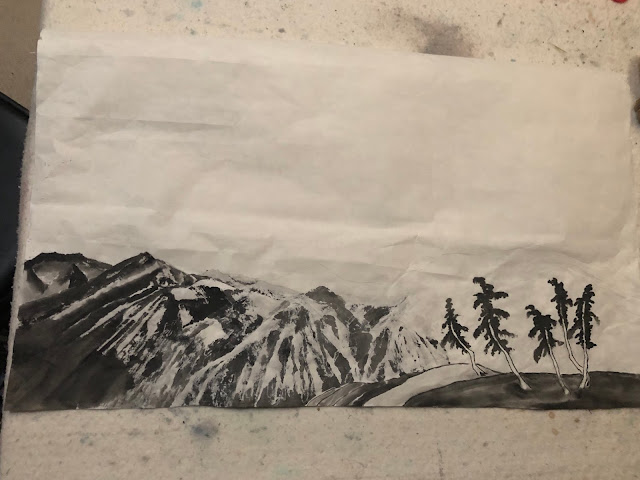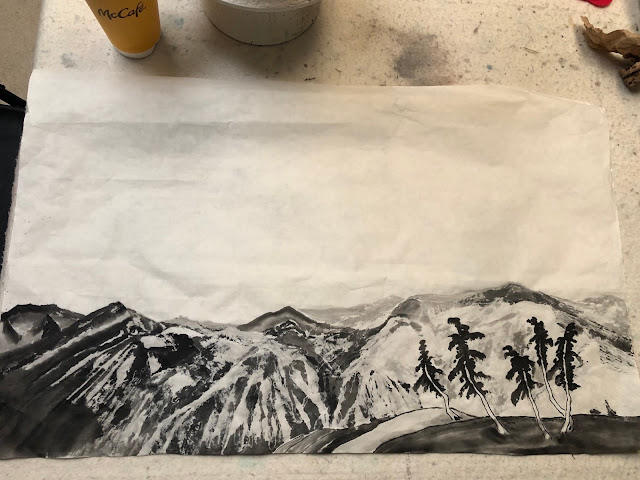Now what?
How do I botch this up ?
I am looking for a vehicle to coalesce these figures and give them a theme, a message. I am looking for a road map to exploit.
Then I chanced up a music score for Pie Jesu. I am a huge fan of Andrew Lloyd Webber and his musicals and I am absolutely infatuated with Sarah Brightman. The score had parts for string instruments like violins, violas and cellos. When I saw the notations on how to play the music, I thought of the similarities between music and calligraphy. In this particular case, between music and my dancing figures.
The individual notes in music is akin to the individual strokes in Chinese writing. The strokes could be horizontal, vertical or dots and occupied a framework in space. The notes occupied positions designated by the staff, building a tune. Tempo of the music is similar to the speed at which the various brushstrokes are laid down in calligraphy, whereas a scherzo and largo might be loosely exemplified by the grass script and the seal script.
So in the Pie Jesu score I saw notation for the bow, i.e. up bow or down bow and I made the association to how the brushstrokes starts and ends. There was legato ( notes slurred together ) for individual, adjacent notes and that is totally similar to how the brushstrokes were treated in Chinese calligraphy. Some brushstrokes need to be assimilated as one in order to build the structure. Phrasing and rhythm are not unique to music, but is evident and required in Chinese calligraphy by how the brush is wielded. I saw notations for tenuto ( holding notes to their full values, sustained ) even when the music is pianissimo. So a common mistake for someone using the Chinese round brush for calligraphy is that when one comes to a thin line one tends to skim over that and not give it the full energy, resulting in what I would characterize as a wilted beansprout. There was notation for pizzicato ( plucking the string ) and arco (playing with the bow) instructing how the musician should sound the notes.
Hence the arms of the ballerinas might dictate long and speedy brushstrokes to distill expression extending to the fingers, not unlike employing thee whole bow to play certain notes to give them character. Whereas the note might be played with only the middle section, or the tip, or the bottom of the bow for different effects, various parts of the brush result in different results too. Thus a turned ankle is done differently from a turned head, a difference between using center tip or side tip technique.
Let us examine the two inserts from above. They show the same word 寒 in both instances. They are from my calligraphy studies of Su Dongpo's Cold Food Festival Te.
The red circled bend on the left insert shows a smooth round turn. Compare that to the red circled area from the right insert, where the bend is a very distinct, angular shoulder. So I would characterize the left insert as an example of legato in brush works, whereas the right insert is an example of pizzicato.
Now the blue circled area from the left insert shows a distinct loop joining the left stroke with the right stroke. An obvious example of a legato, connecting two distinct strokes, heading two different directions, into a single expression. The blue circled example from the right insert does not show the overt loop, but does give a suggestion of the brush turning backwards, as evidenced by the little hump. Whereas this is also a legato, I would also add tenuto ( sustain ) to it to make sure the artist does not lift the brush and maintains the energy throughout the brush travel.
It is very typical for Chinese calligraphers doing the walking or grass style calligraphy to write the same word in varied nuances In other words one never dresses the same words in identical attires. This is a way for the calligrapher to bring his/her hubris and boasts his/her command of the brush. Thus the expression "to read a painting", meaning to appreciate the nuances of the brush through close examination. In a way this is not that different from the variations of a theme in western music, or seeing the theme being employed and developed again and again throughout a musical piece.
Obviously in Chinese calligraphy, or in using the Chinese brush, there are none of these notations.
The knowledge hence rests in a solid Ji Ben Gong (the fundamentals ) and rote learning. The point is, such notations are just as necessary and vital, only that they are not explicitly written down in the arena of Chinese brush calligraphy or painting. I suppose that makes the Chinese brush a tad esoteric. My intent therefore is to demystify the myths and hypes surrounding the Chinese brush art form and relate it to something tangible and equivalent from the western world.
Enough soliloquy, time to roll up my sleeves again.
Once I was tuned in to the resonance between music and calligraphy, I decided to prop my silhouettes of dancers against the background of music score from Pie Jesu.
Laying down the staff was the first task. I thought I had pretty good command of the brush but it was a humiliating experience putting the lines down with a fine brush.
I was trying to be fancy by making my own quill out of a bamboo branch. That too was kind of disastrous. The extemporaneously made bamboo quill had no means of holding ink in a controlled manner. Thus it was all or nothing, resulting in deposit of puddles of ink that I had to blot off in a hurry. I also suspected the abrasive bamboo tip scratched the surface of my Xuan into a more fibrous state, causing the ink to bleed haphazardly upon contact. Fortunately I used a light ink for the purpose of writing down the music score. It didn't take my long to pitch my quill and embraced my round brush again.
It is interesting in hindsight to see how my painting is constructed, borrowing from and finding inspiration from different disciplines, and different cultures. Here my focus isn't so much on the accuracy of anatomical proportions but rather on the expressiveness of the forms. This is not unlike Chinese calligraphy.
Just like the horse hairs on a bow caressing the strings in a fine mist of rosin, my brush too is able to course through the Xuan, seeping ink into the fibers to manifest forms; in both instances, expressing something deeper than what is superficial.

















































